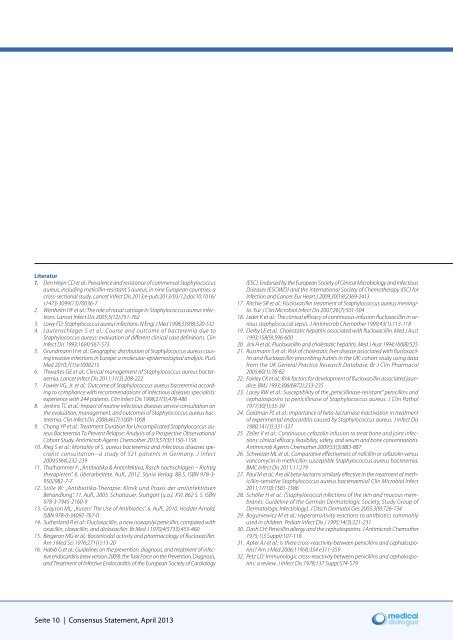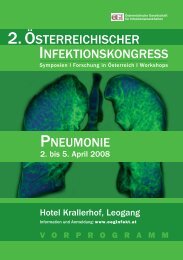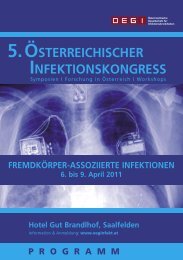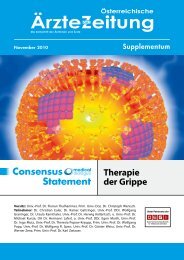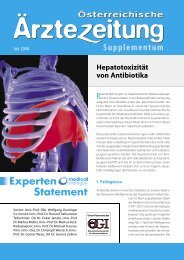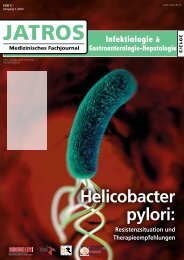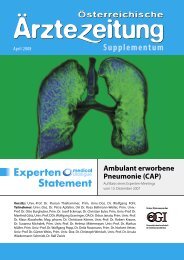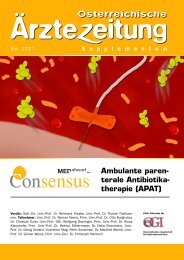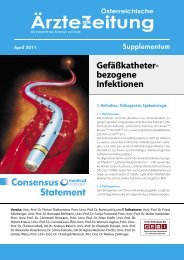PDF 799KB - Österreichische Gesellschaft für Infektionskrankheiten
PDF 799KB - Österreichische Gesellschaft für Infektionskrankheiten
PDF 799KB - Österreichische Gesellschaft für Infektionskrankheiten
- Keine Tags gefunden...
Sie wollen auch ein ePaper? Erhöhen Sie die Reichweite Ihrer Titel.
YUMPU macht aus Druck-PDFs automatisch weboptimierte ePaper, die Google liebt.
Literatur1. Den Heijer CD et al.: Prevalence and resistance of commensal Staphylococcusaureus, including meticillin-resistant S aureus, in nine European countries: across-sectional study. Lancet Infect Dis 2013;e-pub:2013/03/12;doi:10.1016/s1473-3099(13)70036-72. Wertheim HF et al.: The role of nasal carriage in Staphylococcus aureus infections.Lancet Infect Dis 2005;5(12):751-7623. Lowy FD: Staphylococcus aureus infections. N Engl J Med 1998;339(8):520-5324. Lautenschlager S et al.: Course and outcome of bacteremia due toStaphylococcus aureus: evaluation of different clinical case definitions. ClinInfect Dis 1993;16(4):567-5735. Grundmann H et al.: Geographic distribution of Staphylococcus aureus causinginvasive infections in Europe: a molecular-epidemiological analysis. PLoSMed 2010;7(1):e10002156. Thwaites GE et al.: Clinical management of Staphylococcus aureus bacteraemia.Lancet Infect Dis 2011;11(3):208-2227. Fowler VG, Jr. et al.: Outcome of Staphylococcus aureus bacteremia accordingto compliance with recommendations of infectious diseases specialists:experience with 244 patients. Clin Infect Dis 1998;27(3):478-4868. Jenkins TC et al.: Impact of routine infectious diseases service consultation onthe evaluation, management, and outcomes of Staphylococcus aureus bacteremia.Clin Infect Dis 2008;46(7):1000-10089. Chong YP et al.: Treatment Duration for Uncomplicated Staphylococcus aureusBacteremia To Prevent Relapse: Analysis of a Prospective ObservationalCohort Study. Antimicrob Agents Chemother 2013;57(3):1150-115610. Rieg S et al.: Mortality of S. aureus bacteremia and infectious diseases specialistconsultation--a study of 521 patients in Germany. J Infect2009;59(4):232-23911. Thalhammer F: „Antibiotika & Antiinfektiva, Rasch nachschlagen – Richtigtherapieren“. 6. überarbeitete. Aufl., 2012. Styria Verlag. 88 S. ISBN 978-3-9502982-7-712. Stille W: „Antibiotika-Therapie: Klinik und Praxis der antiinfektiösenBehandlung“. 11. Aufl., 2005. Schattauer, Stuttgart [u.a.]. XVI, 862 S. S. ISBN978-3-7945-2160-913. Grayson ML: „Kucers‘ The Use of Antibiotics“. 6. Aufl., 2010. Hodder Arnold,ISBN 978-0-34092-767-014. Sutherland R et al.: Flucloxacillin, a new isoxazolyl penicillin, compared withoxacillin, cloxacillin, and dicloxacillin. Br Med J 1970;4(5733):455-46015. Bergeron MG et al.: Bactericidal activity and pharmacology of flucloxacillin.Am J Med Sci 1976;271(1):13-2016. Habib G et al.: Guidelines on the prevention, diagnosis, and treatment of infectiveendocarditis (new version 2009): the Task Force on the Prevention, Diagnosis,and Treatment of Infective Endocarditis of the European Society of Cardiology(ESC). Endorsed by the European Society of Clinical Microbiology and InfectiousDiseases (ESCMID) and the International Society of Chemotherapy (ISC) forInfection and Cancer. Eur Heart J 2009;30(19):2369-241317. Ritchie SR et al.: Flucloxacillin treatment of Staphylococcus aureus meningitis.Eur J Clin Microbiol Infect Dis 2007;26(7):501-50418. Leder K et al.: The clinical efficacy of continuous-infusion flucloxacillin in seriousstaphylococcal sepsis. J Antimicrob Chemother 1999;43(1):113-11819. Derby LE et al.: Cholestatic hepatitis associated with flucloxacillin. Med J Aust1993;158(9):596-60020. Jick H et al.: Flucloxacillin and cholestatic hepatitis. Med J Aust 1994;160(8):52521. Russmann S et al.: Risk of cholestatic liver disease associated with flucloxacillinand flucloxacillin prescribing habits in the UK: cohort study using datafrom the UK General Practice Research Database. Br J Clin Pharmacol2005;60(1):76-8222. Fairley CK et al.: Risk factors for development of flucloxacillin associated jaundice.BMJ 1993;306(6872):233-23523. Lacey RW et al.: Susceptibility of the „penicillinase-resistant“ penicillins andcephalosporins to penicillinase of Staphylococcus aureus. J Clin Pathol1977;30(1):35-3924. Goldman PL et al.: Importance of beta-lactamase inactivation in treatmentof experimental endocarditis caused by Staphylococcus aureus. J Infect Dis1980;141(3):331-33725. Zeller V et al.: Continuous cefazolin infusion to treat bone and joint infections:clinical efficacy, feasibility, safety, and serum and bone concentrations.Antimicrob Agents Chemother 2009;53(3):883-88726. Schweizer ML et al.: Comparative effectiveness of nafcillin or cefazolin versusvancomycin in methicillin-susceptible Staphylococcus aureus bacteremia.BMC Infect Dis 2011;11:27927. Paul M et al.: Are all beta-lactams similarly effective in the treatment of methicillin-sensitiveStaphylococcus aureus bacteraemia? Clin Microbiol Infect2011;17(10):1581-158628. Schöfer H et al.: [Staphylococcal infections of the skin and mucous membranes.Guideline of the German Dermatologic Society, Study Group ofDermatologic Infectiology]. J Dtsch Dermatol Ges 2005;3(9):726-73429. Boguniewicz M et al.: Hypersensitivity reactions to antibiotics commonlyused in children. Pediatr Infect Dis J 1995;14(3):221-23130. Dash CH: Penicillin allergy and the cephalosporins. J Antimicrob Chemother1975;1(3 Suppl):107-11831. Apter AJ et al.: Is there cross-reactivity between penicillins and cephalosporins?Am J Med 2006;119(4):354 e311-35932. Petz LD: Immunologic cross-reactivity between penicillins and cephalosporins:a review. J Infect Dis 1978;137 Suppl:S74-S79Seite 10 | Consensus Statement, April 2013


